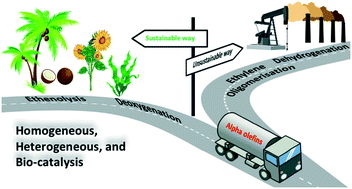Selective production of linear α-olefins via catalytic deoxygenation of fatty acids and derivatives
Abstract
Scientists are exploring renewables as sources for a more sustainable production of chemicals. Linear α-olefins (LAOs) are key commodity chemicals and petrochemical intermediates, which are currently almost exclusively obtained from fossil resources. The most important renewable alternative is plant oil, from which fatty acids and their derivatives can be converted into LAOs by ethenolysis of monounsaturated fatty acids or deoxygenation of saturated ones. The variety, in terms of length, is greater for the saturated fatty acids found in plant oils, and this review covers deoxygenation processes mediated by homogeneous, heterogeneous and enzymatic catalysts and discusses the strengths and weaknesses of different approaches for the selective production of LAOs. Although progress has been made in recent years, the best catalysts in each category are still far from fulfilling the industrial requirements for efficiency, atom economy, and turnover numbers. We hope that our focus on the main remaining challenges will stimulate future research to develop catalysed deoxygenation of fatty acid derivatives as a sustainable and industrially viable route to a range of α-olefins.



 Please wait while we load your content...
Please wait while we load your content...